Negligence in Patient Care: A Critical Analysis of a Case Study
VerifiedAdded on 2023/06/09
|9
|2444
|153
AI Summary
This essay critically analyzes a case study on how negligence due to lack of proper professional goals and awareness in the professional code of conduct might lead to fatal outcomes in patient care. The essay initiates with critical analysis of the case study followed by discussion and personal reflection of the author. The essay also highlights the importance of both clinical and non-clinical skills in the nursing profession.
Contribute Materials
Your contribution can guide someone’s learning journey. Share your
documents today.
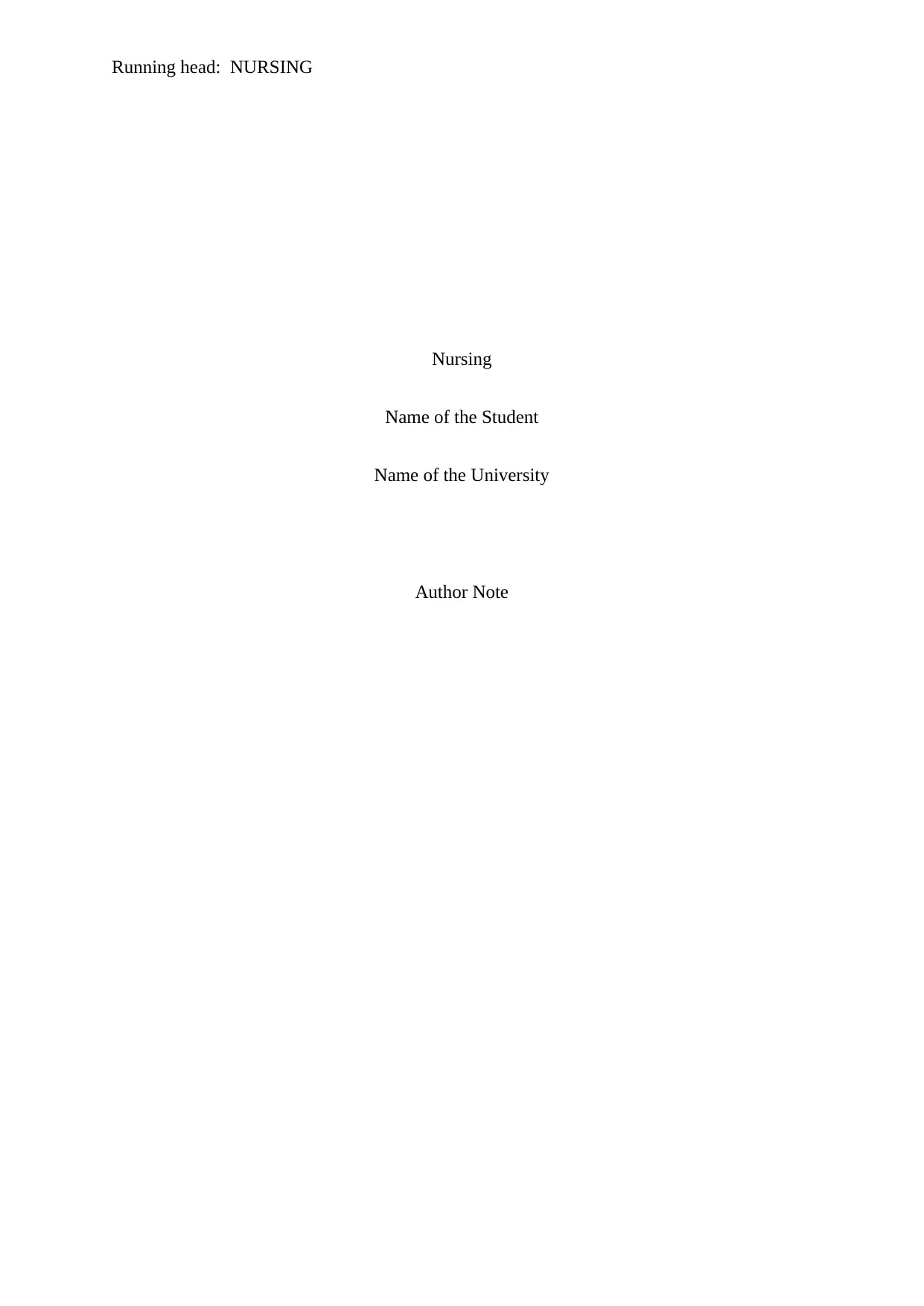
Running head: NURSING
Nursing
Name of the Student
Name of the University
Author Note
Nursing
Name of the Student
Name of the University
Author Note
Secure Best Marks with AI Grader
Need help grading? Try our AI Grader for instant feedback on your assignments.
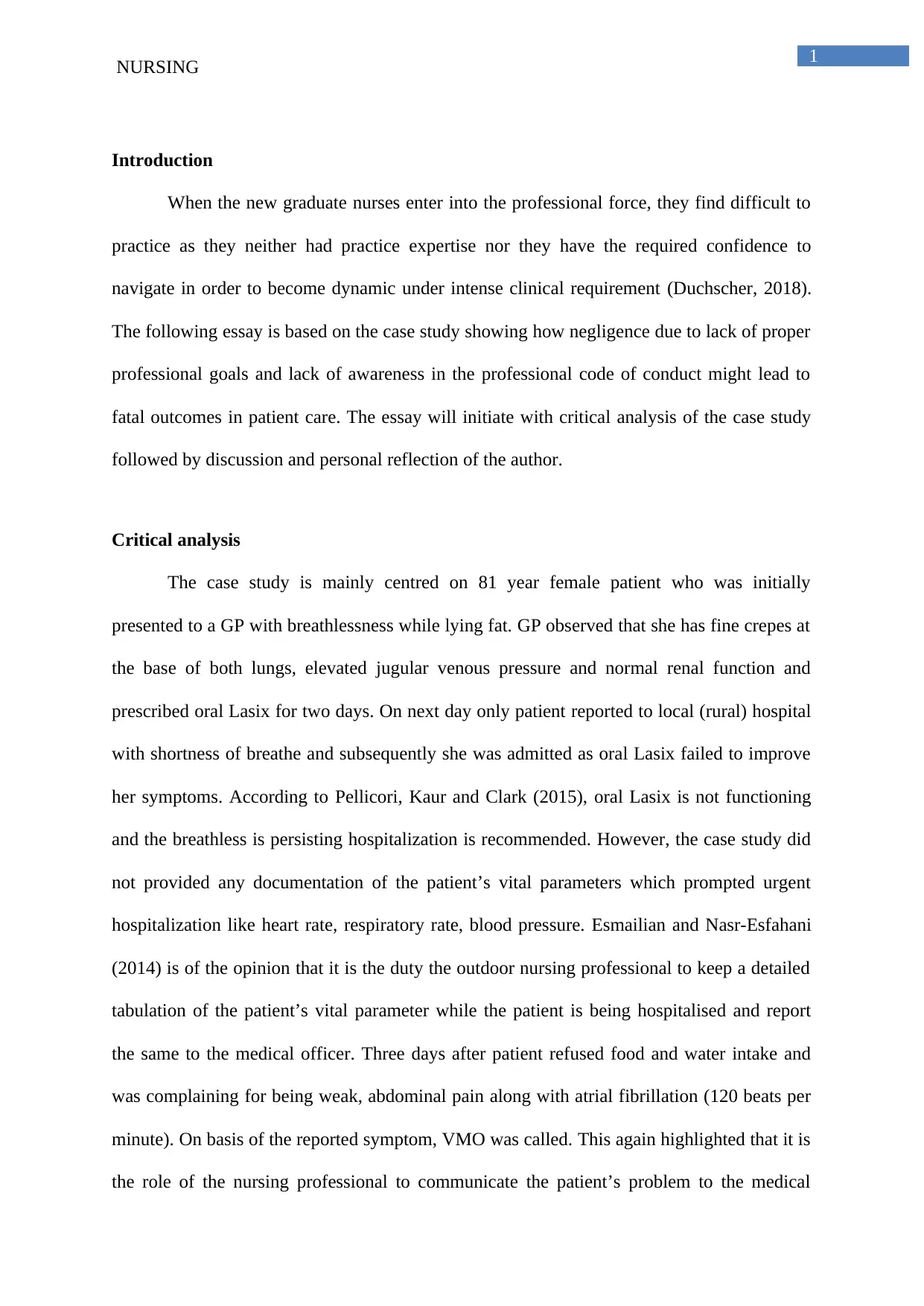
1
NURSING
Introduction
When the new graduate nurses enter into the professional force, they find difficult to
practice as they neither had practice expertise nor they have the required confidence to
navigate in order to become dynamic under intense clinical requirement (Duchscher, 2018).
The following essay is based on the case study showing how negligence due to lack of proper
professional goals and lack of awareness in the professional code of conduct might lead to
fatal outcomes in patient care. The essay will initiate with critical analysis of the case study
followed by discussion and personal reflection of the author.
Critical analysis
The case study is mainly centred on 81 year female patient who was initially
presented to a GP with breathlessness while lying fat. GP observed that she has fine crepes at
the base of both lungs, elevated jugular venous pressure and normal renal function and
prescribed oral Lasix for two days. On next day only patient reported to local (rural) hospital
with shortness of breathe and subsequently she was admitted as oral Lasix failed to improve
her symptoms. According to Pellicori, Kaur and Clark (2015), oral Lasix is not functioning
and the breathless is persisting hospitalization is recommended. However, the case study did
not provided any documentation of the patient’s vital parameters which prompted urgent
hospitalization like heart rate, respiratory rate, blood pressure. Esmailian and Nasr-Esfahani
(2014) is of the opinion that it is the duty the outdoor nursing professional to keep a detailed
tabulation of the patient’s vital parameter while the patient is being hospitalised and report
the same to the medical officer. Three days after patient refused food and water intake and
was complaining for being weak, abdominal pain along with atrial fibrillation (120 beats per
minute). On basis of the reported symptom, VMO was called. This again highlighted that it is
the role of the nursing professional to communicate the patient’s problem to the medical
NURSING
Introduction
When the new graduate nurses enter into the professional force, they find difficult to
practice as they neither had practice expertise nor they have the required confidence to
navigate in order to become dynamic under intense clinical requirement (Duchscher, 2018).
The following essay is based on the case study showing how negligence due to lack of proper
professional goals and lack of awareness in the professional code of conduct might lead to
fatal outcomes in patient care. The essay will initiate with critical analysis of the case study
followed by discussion and personal reflection of the author.
Critical analysis
The case study is mainly centred on 81 year female patient who was initially
presented to a GP with breathlessness while lying fat. GP observed that she has fine crepes at
the base of both lungs, elevated jugular venous pressure and normal renal function and
prescribed oral Lasix for two days. On next day only patient reported to local (rural) hospital
with shortness of breathe and subsequently she was admitted as oral Lasix failed to improve
her symptoms. According to Pellicori, Kaur and Clark (2015), oral Lasix is not functioning
and the breathless is persisting hospitalization is recommended. However, the case study did
not provided any documentation of the patient’s vital parameters which prompted urgent
hospitalization like heart rate, respiratory rate, blood pressure. Esmailian and Nasr-Esfahani
(2014) is of the opinion that it is the duty the outdoor nursing professional to keep a detailed
tabulation of the patient’s vital parameter while the patient is being hospitalised and report
the same to the medical officer. Three days after patient refused food and water intake and
was complaining for being weak, abdominal pain along with atrial fibrillation (120 beats per
minute). On basis of the reported symptom, VMO was called. This again highlighted that it is
the role of the nursing professional to communicate the patient’s problem to the medical
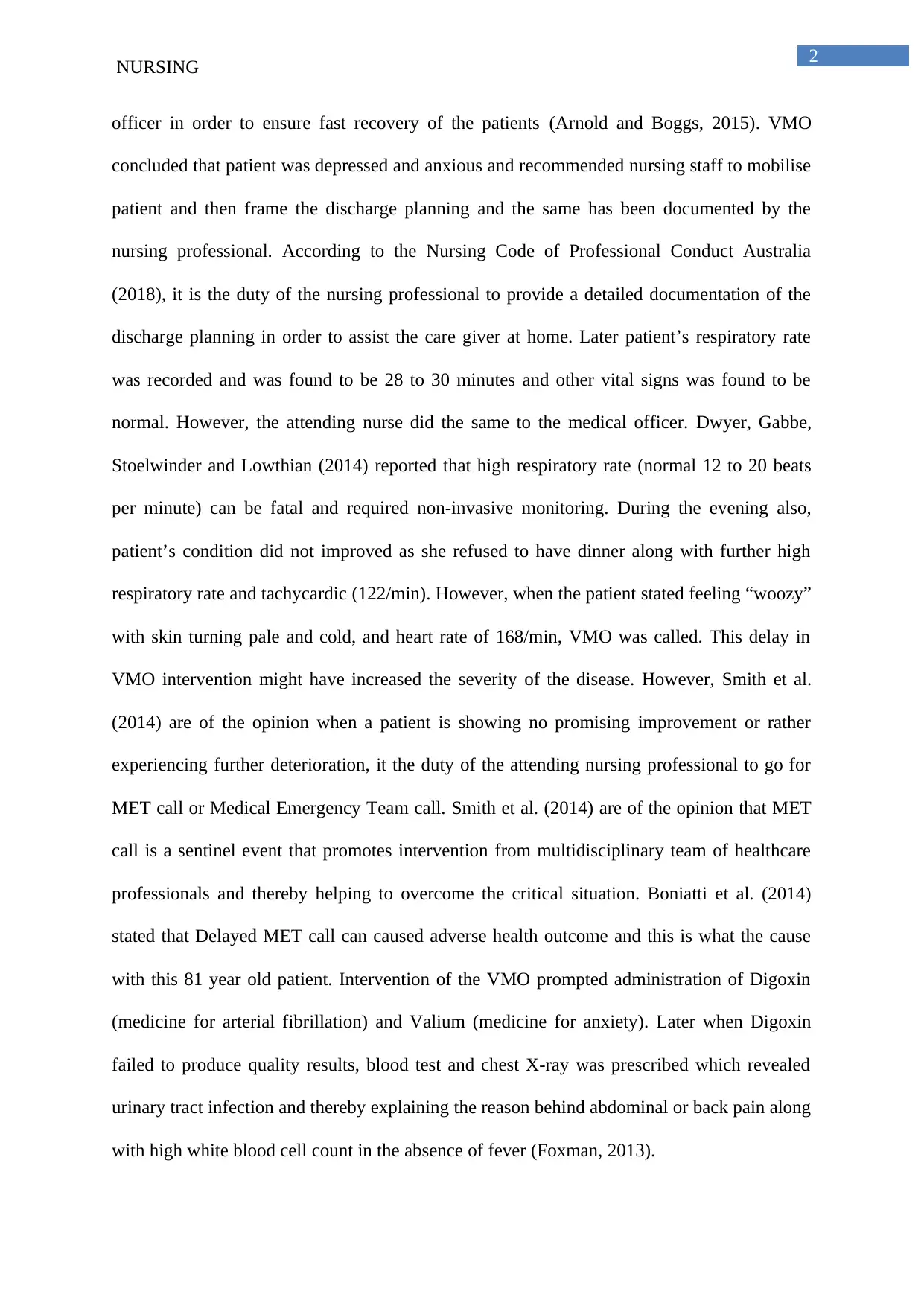
2
NURSING
officer in order to ensure fast recovery of the patients (Arnold and Boggs, 2015). VMO
concluded that patient was depressed and anxious and recommended nursing staff to mobilise
patient and then frame the discharge planning and the same has been documented by the
nursing professional. According to the Nursing Code of Professional Conduct Australia
(2018), it is the duty of the nursing professional to provide a detailed documentation of the
discharge planning in order to assist the care giver at home. Later patient’s respiratory rate
was recorded and was found to be 28 to 30 minutes and other vital signs was found to be
normal. However, the attending nurse did the same to the medical officer. Dwyer, Gabbe,
Stoelwinder and Lowthian (2014) reported that high respiratory rate (normal 12 to 20 beats
per minute) can be fatal and required non-invasive monitoring. During the evening also,
patient’s condition did not improved as she refused to have dinner along with further high
respiratory rate and tachycardic (122/min). However, when the patient stated feeling “woozy”
with skin turning pale and cold, and heart rate of 168/min, VMO was called. This delay in
VMO intervention might have increased the severity of the disease. However, Smith et al.
(2014) are of the opinion when a patient is showing no promising improvement or rather
experiencing further deterioration, it the duty of the attending nursing professional to go for
MET call or Medical Emergency Team call. Smith et al. (2014) are of the opinion that MET
call is a sentinel event that promotes intervention from multidisciplinary team of healthcare
professionals and thereby helping to overcome the critical situation. Boniatti et al. (2014)
stated that Delayed MET call can caused adverse health outcome and this is what the cause
with this 81 year old patient. Intervention of the VMO prompted administration of Digoxin
(medicine for arterial fibrillation) and Valium (medicine for anxiety). Later when Digoxin
failed to produce quality results, blood test and chest X-ray was prescribed which revealed
urinary tract infection and thereby explaining the reason behind abdominal or back pain along
with high white blood cell count in the absence of fever (Foxman, 2013).
NURSING
officer in order to ensure fast recovery of the patients (Arnold and Boggs, 2015). VMO
concluded that patient was depressed and anxious and recommended nursing staff to mobilise
patient and then frame the discharge planning and the same has been documented by the
nursing professional. According to the Nursing Code of Professional Conduct Australia
(2018), it is the duty of the nursing professional to provide a detailed documentation of the
discharge planning in order to assist the care giver at home. Later patient’s respiratory rate
was recorded and was found to be 28 to 30 minutes and other vital signs was found to be
normal. However, the attending nurse did the same to the medical officer. Dwyer, Gabbe,
Stoelwinder and Lowthian (2014) reported that high respiratory rate (normal 12 to 20 beats
per minute) can be fatal and required non-invasive monitoring. During the evening also,
patient’s condition did not improved as she refused to have dinner along with further high
respiratory rate and tachycardic (122/min). However, when the patient stated feeling “woozy”
with skin turning pale and cold, and heart rate of 168/min, VMO was called. This delay in
VMO intervention might have increased the severity of the disease. However, Smith et al.
(2014) are of the opinion when a patient is showing no promising improvement or rather
experiencing further deterioration, it the duty of the attending nursing professional to go for
MET call or Medical Emergency Team call. Smith et al. (2014) are of the opinion that MET
call is a sentinel event that promotes intervention from multidisciplinary team of healthcare
professionals and thereby helping to overcome the critical situation. Boniatti et al. (2014)
stated that Delayed MET call can caused adverse health outcome and this is what the cause
with this 81 year old patient. Intervention of the VMO prompted administration of Digoxin
(medicine for arterial fibrillation) and Valium (medicine for anxiety). Later when Digoxin
failed to produce quality results, blood test and chest X-ray was prescribed which revealed
urinary tract infection and thereby explaining the reason behind abdominal or back pain along
with high white blood cell count in the absence of fever (Foxman, 2013).
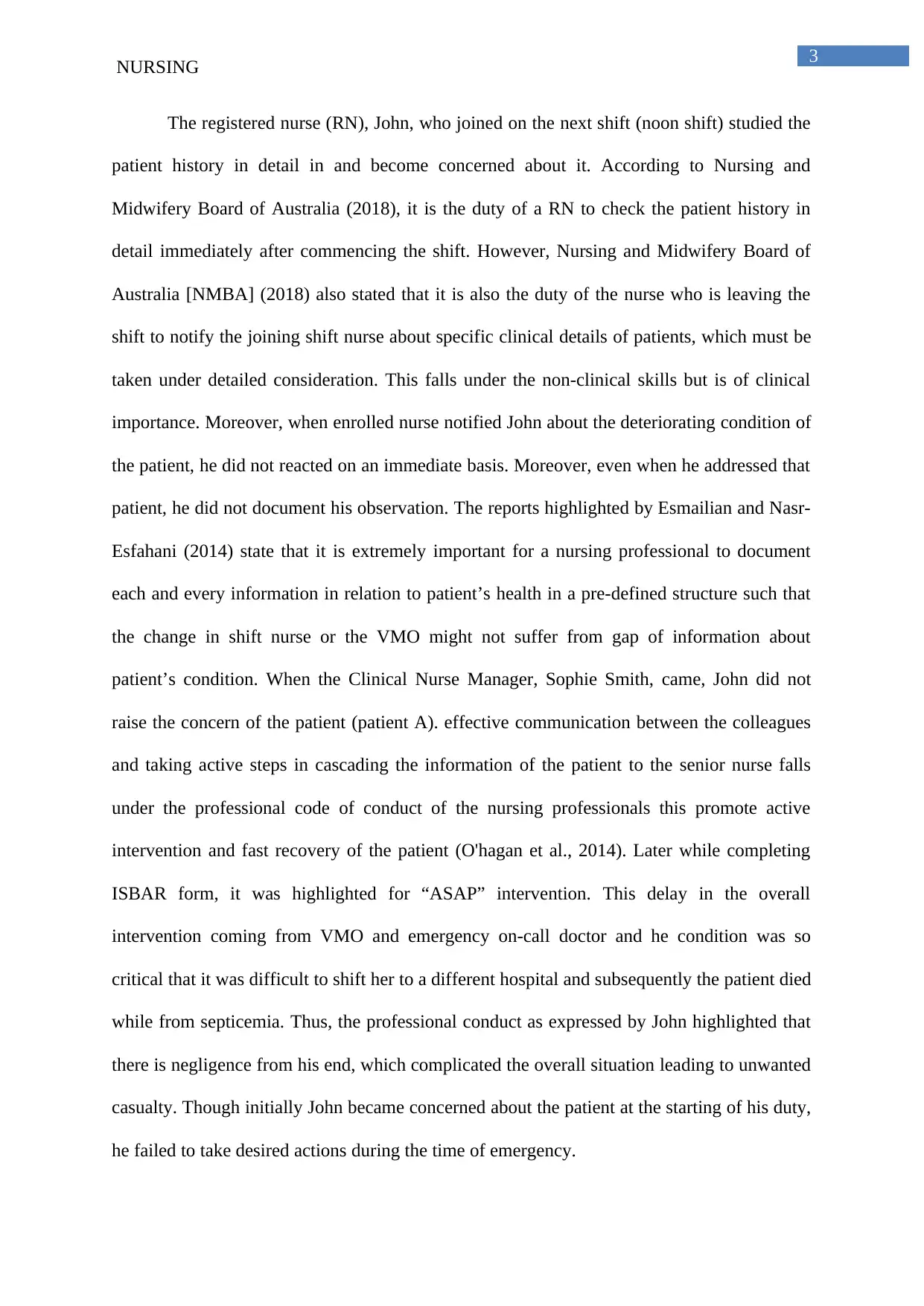
3
NURSING
The registered nurse (RN), John, who joined on the next shift (noon shift) studied the
patient history in detail in and become concerned about it. According to Nursing and
Midwifery Board of Australia (2018), it is the duty of a RN to check the patient history in
detail immediately after commencing the shift. However, Nursing and Midwifery Board of
Australia [NMBA] (2018) also stated that it is also the duty of the nurse who is leaving the
shift to notify the joining shift nurse about specific clinical details of patients, which must be
taken under detailed consideration. This falls under the non-clinical skills but is of clinical
importance. Moreover, when enrolled nurse notified John about the deteriorating condition of
the patient, he did not reacted on an immediate basis. Moreover, even when he addressed that
patient, he did not document his observation. The reports highlighted by Esmailian and Nasr-
Esfahani (2014) state that it is extremely important for a nursing professional to document
each and every information in relation to patient’s health in a pre-defined structure such that
the change in shift nurse or the VMO might not suffer from gap of information about
patient’s condition. When the Clinical Nurse Manager, Sophie Smith, came, John did not
raise the concern of the patient (patient A). effective communication between the colleagues
and taking active steps in cascading the information of the patient to the senior nurse falls
under the professional code of conduct of the nursing professionals this promote active
intervention and fast recovery of the patient (O'hagan et al., 2014). Later while completing
ISBAR form, it was highlighted for “ASAP” intervention. This delay in the overall
intervention coming from VMO and emergency on-call doctor and he condition was so
critical that it was difficult to shift her to a different hospital and subsequently the patient died
while from septicemia. Thus, the professional conduct as expressed by John highlighted that
there is negligence from his end, which complicated the overall situation leading to unwanted
casualty. Though initially John became concerned about the patient at the starting of his duty,
he failed to take desired actions during the time of emergency.
NURSING
The registered nurse (RN), John, who joined on the next shift (noon shift) studied the
patient history in detail in and become concerned about it. According to Nursing and
Midwifery Board of Australia (2018), it is the duty of a RN to check the patient history in
detail immediately after commencing the shift. However, Nursing and Midwifery Board of
Australia [NMBA] (2018) also stated that it is also the duty of the nurse who is leaving the
shift to notify the joining shift nurse about specific clinical details of patients, which must be
taken under detailed consideration. This falls under the non-clinical skills but is of clinical
importance. Moreover, when enrolled nurse notified John about the deteriorating condition of
the patient, he did not reacted on an immediate basis. Moreover, even when he addressed that
patient, he did not document his observation. The reports highlighted by Esmailian and Nasr-
Esfahani (2014) state that it is extremely important for a nursing professional to document
each and every information in relation to patient’s health in a pre-defined structure such that
the change in shift nurse or the VMO might not suffer from gap of information about
patient’s condition. When the Clinical Nurse Manager, Sophie Smith, came, John did not
raise the concern of the patient (patient A). effective communication between the colleagues
and taking active steps in cascading the information of the patient to the senior nurse falls
under the professional code of conduct of the nursing professionals this promote active
intervention and fast recovery of the patient (O'hagan et al., 2014). Later while completing
ISBAR form, it was highlighted for “ASAP” intervention. This delay in the overall
intervention coming from VMO and emergency on-call doctor and he condition was so
critical that it was difficult to shift her to a different hospital and subsequently the patient died
while from septicemia. Thus, the professional conduct as expressed by John highlighted that
there is negligence from his end, which complicated the overall situation leading to unwanted
casualty. Though initially John became concerned about the patient at the starting of his duty,
he failed to take desired actions during the time of emergency.
Secure Best Marks with AI Grader
Need help grading? Try our AI Grader for instant feedback on your assignments.
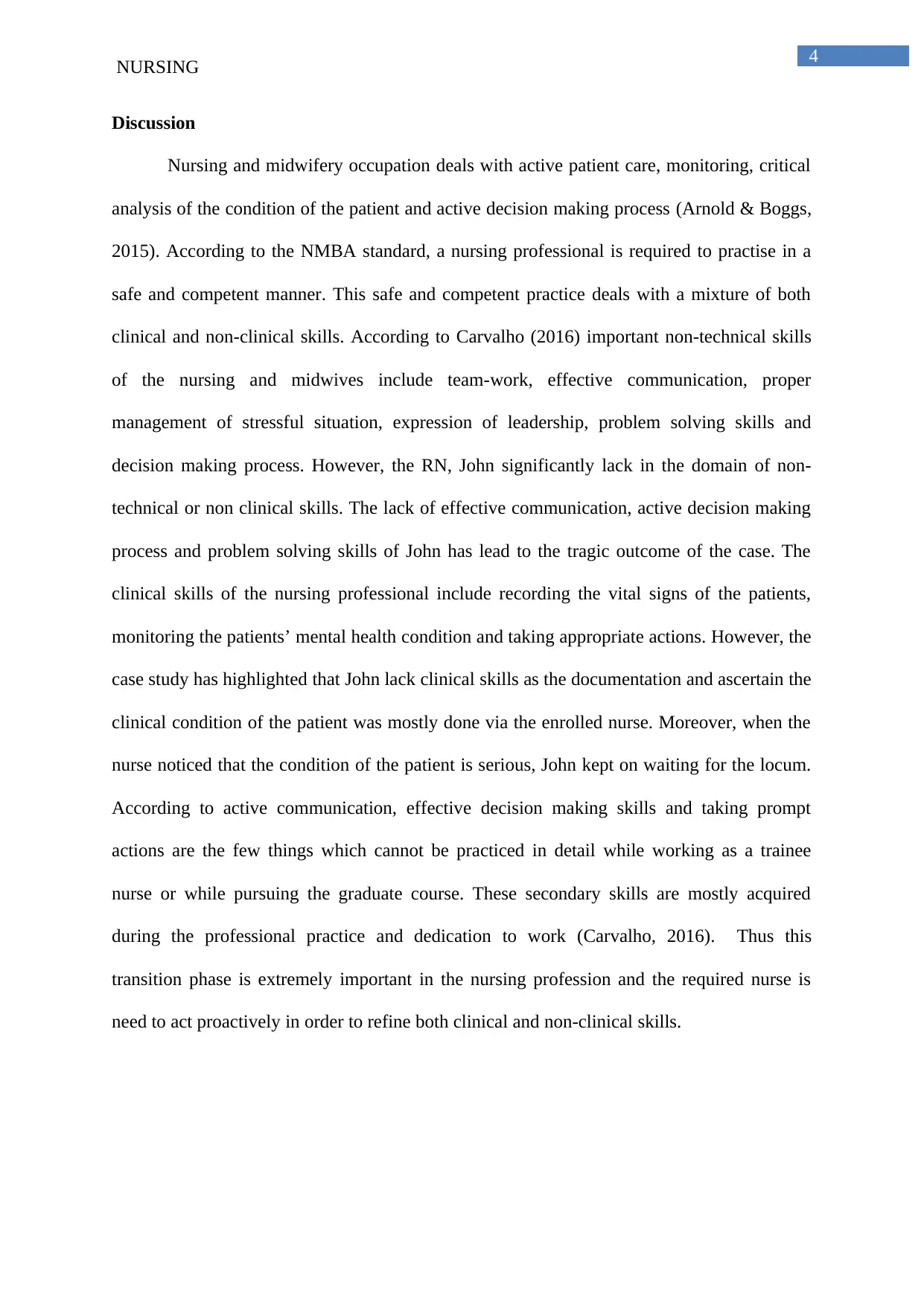
4
NURSING
Discussion
Nursing and midwifery occupation deals with active patient care, monitoring, critical
analysis of the condition of the patient and active decision making process (Arnold & Boggs,
2015). According to the NMBA standard, a nursing professional is required to practise in a
safe and competent manner. This safe and competent practice deals with a mixture of both
clinical and non-clinical skills. According to Carvalho (2016) important non-technical skills
of the nursing and midwives include team-work, effective communication, proper
management of stressful situation, expression of leadership, problem solving skills and
decision making process. However, the RN, John significantly lack in the domain of non-
technical or non clinical skills. The lack of effective communication, active decision making
process and problem solving skills of John has lead to the tragic outcome of the case. The
clinical skills of the nursing professional include recording the vital signs of the patients,
monitoring the patients’ mental health condition and taking appropriate actions. However, the
case study has highlighted that John lack clinical skills as the documentation and ascertain the
clinical condition of the patient was mostly done via the enrolled nurse. Moreover, when the
nurse noticed that the condition of the patient is serious, John kept on waiting for the locum.
According to active communication, effective decision making skills and taking prompt
actions are the few things which cannot be practiced in detail while working as a trainee
nurse or while pursuing the graduate course. These secondary skills are mostly acquired
during the professional practice and dedication to work (Carvalho, 2016). Thus this
transition phase is extremely important in the nursing profession and the required nurse is
need to act proactively in order to refine both clinical and non-clinical skills.
NURSING
Discussion
Nursing and midwifery occupation deals with active patient care, monitoring, critical
analysis of the condition of the patient and active decision making process (Arnold & Boggs,
2015). According to the NMBA standard, a nursing professional is required to practise in a
safe and competent manner. This safe and competent practice deals with a mixture of both
clinical and non-clinical skills. According to Carvalho (2016) important non-technical skills
of the nursing and midwives include team-work, effective communication, proper
management of stressful situation, expression of leadership, problem solving skills and
decision making process. However, the RN, John significantly lack in the domain of non-
technical or non clinical skills. The lack of effective communication, active decision making
process and problem solving skills of John has lead to the tragic outcome of the case. The
clinical skills of the nursing professional include recording the vital signs of the patients,
monitoring the patients’ mental health condition and taking appropriate actions. However, the
case study has highlighted that John lack clinical skills as the documentation and ascertain the
clinical condition of the patient was mostly done via the enrolled nurse. Moreover, when the
nurse noticed that the condition of the patient is serious, John kept on waiting for the locum.
According to active communication, effective decision making skills and taking prompt
actions are the few things which cannot be practiced in detail while working as a trainee
nurse or while pursuing the graduate course. These secondary skills are mostly acquired
during the professional practice and dedication to work (Carvalho, 2016). Thus this
transition phase is extremely important in the nursing profession and the required nurse is
need to act proactively in order to refine both clinical and non-clinical skills.
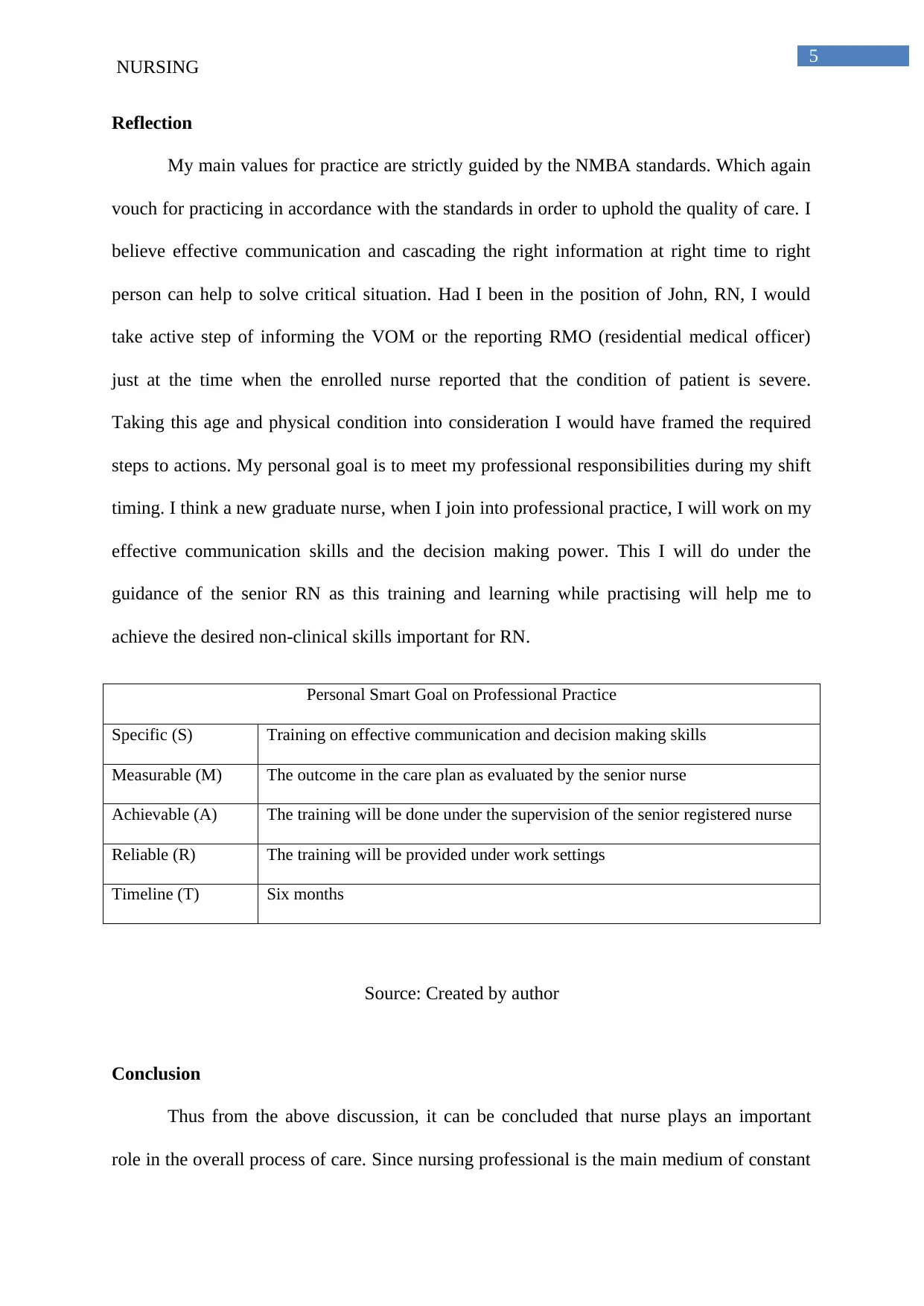
5
NURSING
Reflection
My main values for practice are strictly guided by the NMBA standards. Which again
vouch for practicing in accordance with the standards in order to uphold the quality of care. I
believe effective communication and cascading the right information at right time to right
person can help to solve critical situation. Had I been in the position of John, RN, I would
take active step of informing the VOM or the reporting RMO (residential medical officer)
just at the time when the enrolled nurse reported that the condition of patient is severe.
Taking this age and physical condition into consideration I would have framed the required
steps to actions. My personal goal is to meet my professional responsibilities during my shift
timing. I think a new graduate nurse, when I join into professional practice, I will work on my
effective communication skills and the decision making power. This I will do under the
guidance of the senior RN as this training and learning while practising will help me to
achieve the desired non-clinical skills important for RN.
Personal Smart Goal on Professional Practice
Specific (S) Training on effective communication and decision making skills
Measurable (M) The outcome in the care plan as evaluated by the senior nurse
Achievable (A) The training will be done under the supervision of the senior registered nurse
Reliable (R) The training will be provided under work settings
Timeline (T) Six months
Source: Created by author
Conclusion
Thus from the above discussion, it can be concluded that nurse plays an important
role in the overall process of care. Since nursing professional is the main medium of constant
NURSING
Reflection
My main values for practice are strictly guided by the NMBA standards. Which again
vouch for practicing in accordance with the standards in order to uphold the quality of care. I
believe effective communication and cascading the right information at right time to right
person can help to solve critical situation. Had I been in the position of John, RN, I would
take active step of informing the VOM or the reporting RMO (residential medical officer)
just at the time when the enrolled nurse reported that the condition of patient is severe.
Taking this age and physical condition into consideration I would have framed the required
steps to actions. My personal goal is to meet my professional responsibilities during my shift
timing. I think a new graduate nurse, when I join into professional practice, I will work on my
effective communication skills and the decision making power. This I will do under the
guidance of the senior RN as this training and learning while practising will help me to
achieve the desired non-clinical skills important for RN.
Personal Smart Goal on Professional Practice
Specific (S) Training on effective communication and decision making skills
Measurable (M) The outcome in the care plan as evaluated by the senior nurse
Achievable (A) The training will be done under the supervision of the senior registered nurse
Reliable (R) The training will be provided under work settings
Timeline (T) Six months
Source: Created by author
Conclusion
Thus from the above discussion, it can be concluded that nurse plays an important
role in the overall process of care. Since nursing professional is the main medium of constant
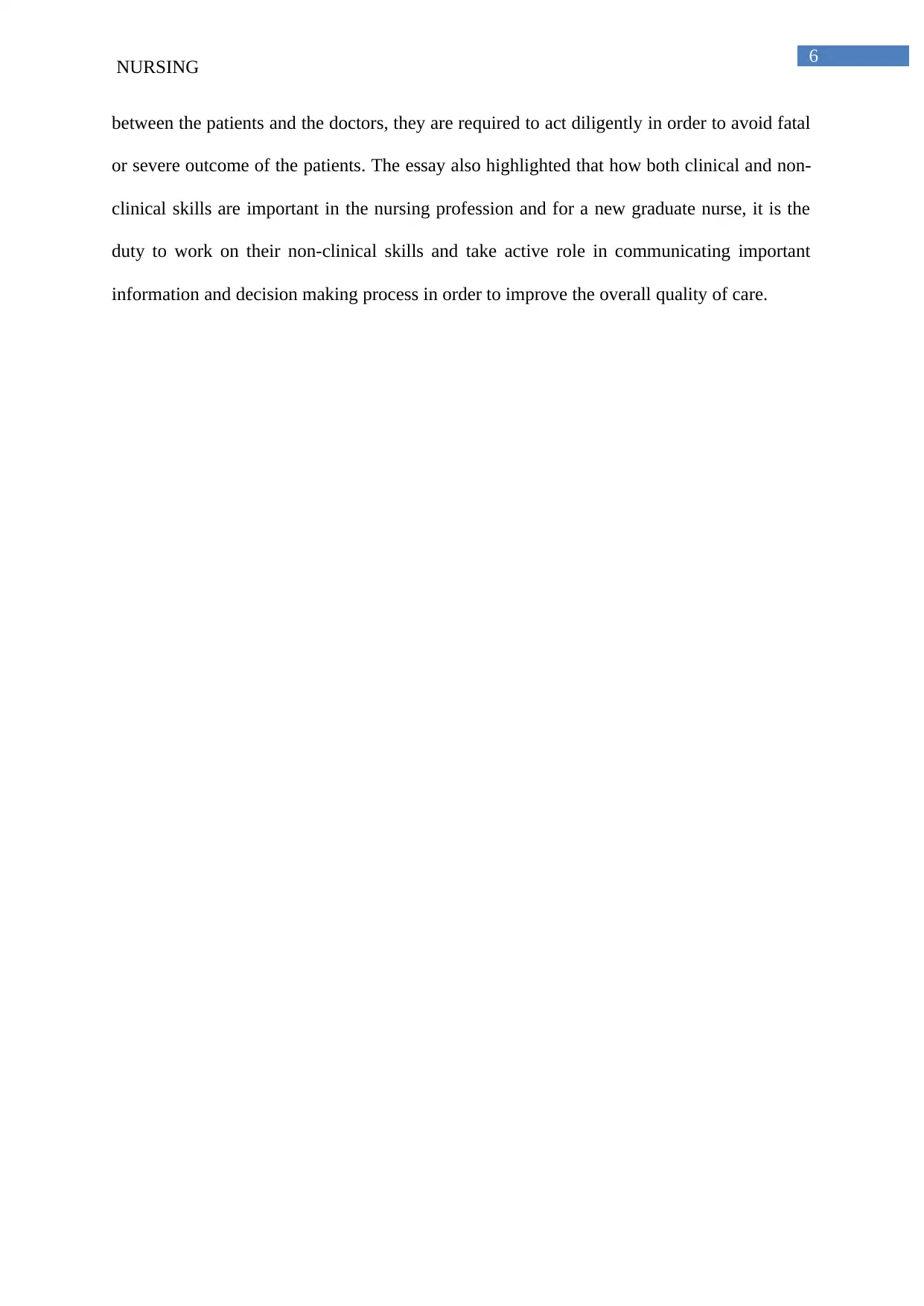
6
NURSING
between the patients and the doctors, they are required to act diligently in order to avoid fatal
or severe outcome of the patients. The essay also highlighted that how both clinical and non-
clinical skills are important in the nursing profession and for a new graduate nurse, it is the
duty to work on their non-clinical skills and take active role in communicating important
information and decision making process in order to improve the overall quality of care.
NURSING
between the patients and the doctors, they are required to act diligently in order to avoid fatal
or severe outcome of the patients. The essay also highlighted that how both clinical and non-
clinical skills are important in the nursing profession and for a new graduate nurse, it is the
duty to work on their non-clinical skills and take active role in communicating important
information and decision making process in order to improve the overall quality of care.
Paraphrase This Document
Need a fresh take? Get an instant paraphrase of this document with our AI Paraphraser
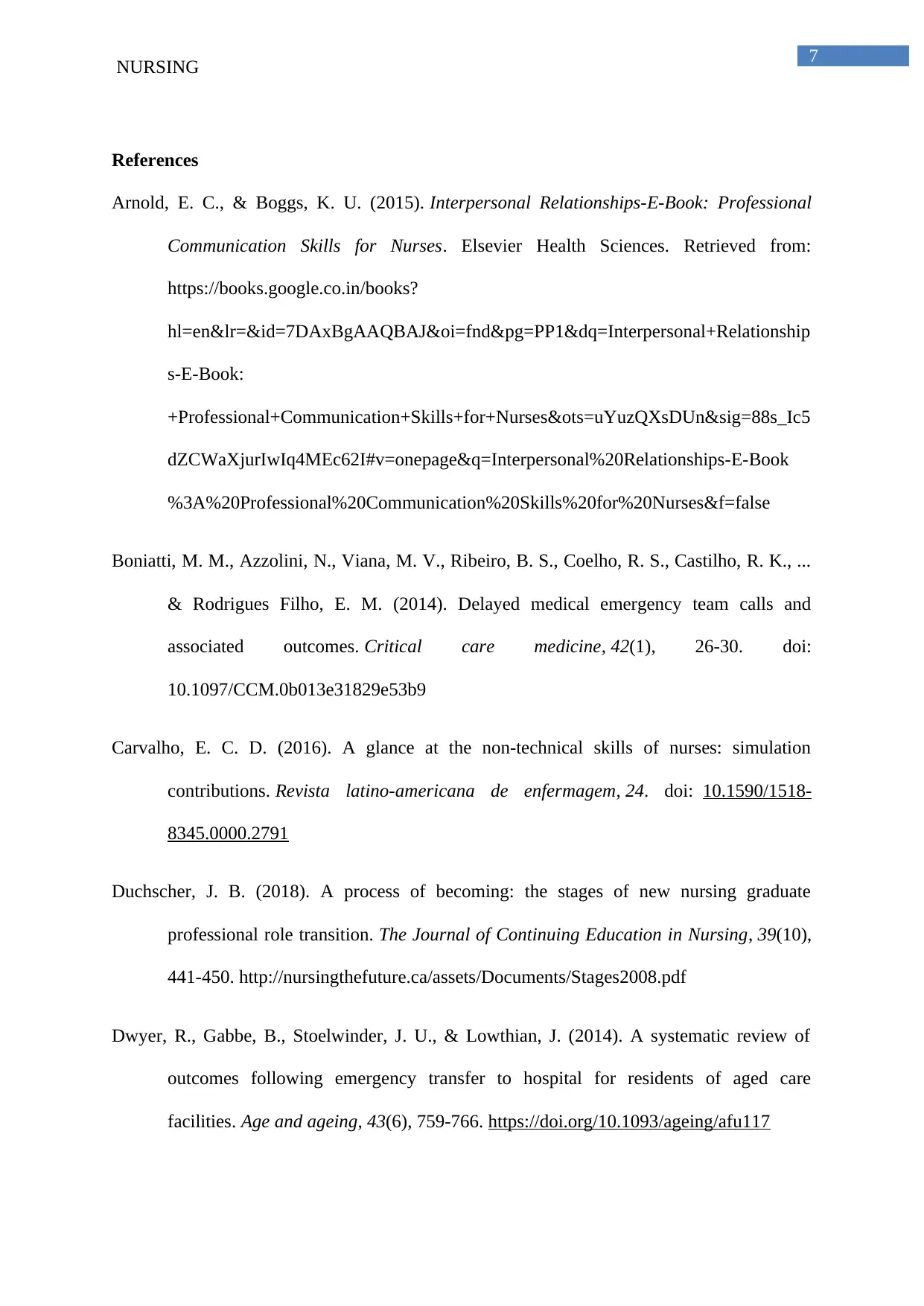
7
NURSING
References
Arnold, E. C., & Boggs, K. U. (2015). Interpersonal Relationships-E-Book: Professional
Communication Skills for Nurses. Elsevier Health Sciences. Retrieved from:
https://books.google.co.in/books?
hl=en&lr=&id=7DAxBgAAQBAJ&oi=fnd&pg=PP1&dq=Interpersonal+Relationship
s-E-Book:
+Professional+Communication+Skills+for+Nurses&ots=uYuzQXsDUn&sig=88s_Ic5
dZCWaXjurIwIq4MEc62I#v=onepage&q=Interpersonal%20Relationships-E-Book
%3A%20Professional%20Communication%20Skills%20for%20Nurses&f=false
Boniatti, M. M., Azzolini, N., Viana, M. V., Ribeiro, B. S., Coelho, R. S., Castilho, R. K., ...
& Rodrigues Filho, E. M. (2014). Delayed medical emergency team calls and
associated outcomes. Critical care medicine, 42(1), 26-30. doi:
10.1097/CCM.0b013e31829e53b9
Carvalho, E. C. D. (2016). A glance at the non-technical skills of nurses: simulation
contributions. Revista latino-americana de enfermagem, 24. doi: 10.1590/1518-
8345.0000.2791
Duchscher, J. B. (2018). A process of becoming: the stages of new nursing graduate
professional role transition. The Journal of Continuing Education in Nursing, 39(10),
441-450. http://nursingthefuture.ca/assets/Documents/Stages2008.pdf
Dwyer, R., Gabbe, B., Stoelwinder, J. U., & Lowthian, J. (2014). A systematic review of
outcomes following emergency transfer to hospital for residents of aged care
facilities. Age and ageing, 43(6), 759-766. https://doi.org/10.1093/ageing/afu117
NURSING
References
Arnold, E. C., & Boggs, K. U. (2015). Interpersonal Relationships-E-Book: Professional
Communication Skills for Nurses. Elsevier Health Sciences. Retrieved from:
https://books.google.co.in/books?
hl=en&lr=&id=7DAxBgAAQBAJ&oi=fnd&pg=PP1&dq=Interpersonal+Relationship
s-E-Book:
+Professional+Communication+Skills+for+Nurses&ots=uYuzQXsDUn&sig=88s_Ic5
dZCWaXjurIwIq4MEc62I#v=onepage&q=Interpersonal%20Relationships-E-Book
%3A%20Professional%20Communication%20Skills%20for%20Nurses&f=false
Boniatti, M. M., Azzolini, N., Viana, M. V., Ribeiro, B. S., Coelho, R. S., Castilho, R. K., ...
& Rodrigues Filho, E. M. (2014). Delayed medical emergency team calls and
associated outcomes. Critical care medicine, 42(1), 26-30. doi:
10.1097/CCM.0b013e31829e53b9
Carvalho, E. C. D. (2016). A glance at the non-technical skills of nurses: simulation
contributions. Revista latino-americana de enfermagem, 24. doi: 10.1590/1518-
8345.0000.2791
Duchscher, J. B. (2018). A process of becoming: the stages of new nursing graduate
professional role transition. The Journal of Continuing Education in Nursing, 39(10),
441-450. http://nursingthefuture.ca/assets/Documents/Stages2008.pdf
Dwyer, R., Gabbe, B., Stoelwinder, J. U., & Lowthian, J. (2014). A systematic review of
outcomes following emergency transfer to hospital for residents of aged care
facilities. Age and ageing, 43(6), 759-766. https://doi.org/10.1093/ageing/afu117
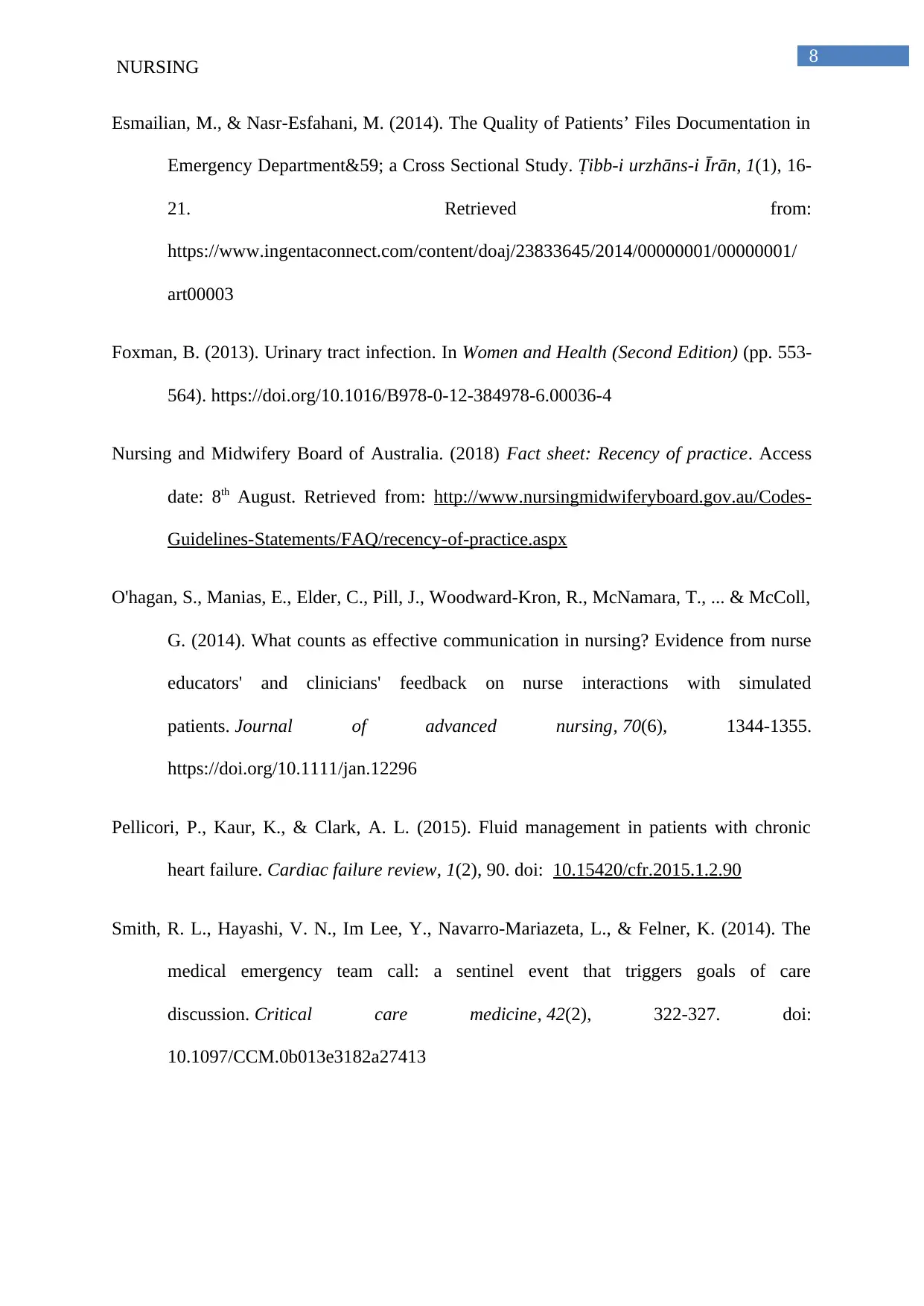
8
NURSING
Esmailian, M., & Nasr-Esfahani, M. (2014). The Quality of Patients’ Files Documentation in
Emergency Department&59; a Cross Sectional Study. Ṭibb-i urzhāns-i Īrān, 1(1), 16-
21. Retrieved from:
https://www.ingentaconnect.com/content/doaj/23833645/2014/00000001/00000001/
art00003
Foxman, B. (2013). Urinary tract infection. In Women and Health (Second Edition) (pp. 553-
564). https://doi.org/10.1016/B978-0-12-384978-6.00036-4
Nursing and Midwifery Board of Australia. (2018) Fact sheet: Recency of practice. Access
date: 8th August. Retrieved from: http://www.nursingmidwiferyboard.gov.au/Codes-
Guidelines-Statements/FAQ/recency-of-practice.aspx
O'hagan, S., Manias, E., Elder, C., Pill, J., Woodward‐Kron, R., McNamara, T., ... & McColl,
G. (2014). What counts as effective communication in nursing? Evidence from nurse
educators' and clinicians' feedback on nurse interactions with simulated
patients. Journal of advanced nursing, 70(6), 1344-1355.
https://doi.org/10.1111/jan.12296
Pellicori, P., Kaur, K., & Clark, A. L. (2015). Fluid management in patients with chronic
heart failure. Cardiac failure review, 1(2), 90. doi: 10.15420/cfr.2015.1.2.90
Smith, R. L., Hayashi, V. N., Im Lee, Y., Navarro-Mariazeta, L., & Felner, K. (2014). The
medical emergency team call: a sentinel event that triggers goals of care
discussion. Critical care medicine, 42(2), 322-327. doi:
10.1097/CCM.0b013e3182a27413
NURSING
Esmailian, M., & Nasr-Esfahani, M. (2014). The Quality of Patients’ Files Documentation in
Emergency Department&59; a Cross Sectional Study. Ṭibb-i urzhāns-i Īrān, 1(1), 16-
21. Retrieved from:
https://www.ingentaconnect.com/content/doaj/23833645/2014/00000001/00000001/
art00003
Foxman, B. (2013). Urinary tract infection. In Women and Health (Second Edition) (pp. 553-
564). https://doi.org/10.1016/B978-0-12-384978-6.00036-4
Nursing and Midwifery Board of Australia. (2018) Fact sheet: Recency of practice. Access
date: 8th August. Retrieved from: http://www.nursingmidwiferyboard.gov.au/Codes-
Guidelines-Statements/FAQ/recency-of-practice.aspx
O'hagan, S., Manias, E., Elder, C., Pill, J., Woodward‐Kron, R., McNamara, T., ... & McColl,
G. (2014). What counts as effective communication in nursing? Evidence from nurse
educators' and clinicians' feedback on nurse interactions with simulated
patients. Journal of advanced nursing, 70(6), 1344-1355.
https://doi.org/10.1111/jan.12296
Pellicori, P., Kaur, K., & Clark, A. L. (2015). Fluid management in patients with chronic
heart failure. Cardiac failure review, 1(2), 90. doi: 10.15420/cfr.2015.1.2.90
Smith, R. L., Hayashi, V. N., Im Lee, Y., Navarro-Mariazeta, L., & Felner, K. (2014). The
medical emergency team call: a sentinel event that triggers goals of care
discussion. Critical care medicine, 42(2), 322-327. doi:
10.1097/CCM.0b013e3182a27413
1 out of 9
Related Documents
Your All-in-One AI-Powered Toolkit for Academic Success.
+13062052269
info@desklib.com
Available 24*7 on WhatsApp / Email
![[object Object]](/_next/static/media/star-bottom.7253800d.svg)
Unlock your academic potential
© 2024 | Zucol Services PVT LTD | All rights reserved.





